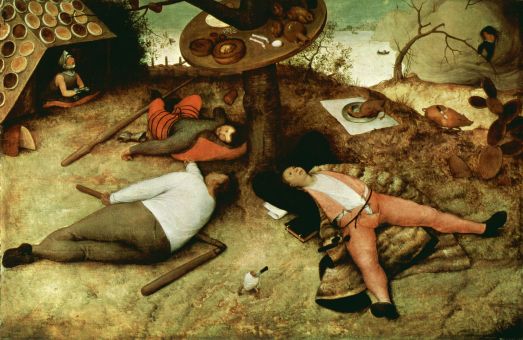I recently finished reading a fascinating little book* about the history and symbolism of colours, and I thought I’d share with you some of the interesting linguistic facts about colour that I learnt.
1. In Roman times blue was a difficult dye to make, and was considered to be the colour of all that was foreign and barbaric. One result of this is that the Romance languages words for ‘blue’ are of Germanic (‘blau‘) or Arabic origin (‘لازورد ‘lāzaward‘ for ‘azure’, deriving from lapis lazuli) as no Latin word existed.
2. Early medieval woad dyers became so wealthy that the regions of France where this blue plant dye was cultivated became known in French as the pays de cocagne, cocagne being the ball of woad leaves used by the dyers. 80% of Amiens cathedral was paid for by woad merchants! English has kept the term ‘cockaigne‘ or ‘cockayne’, but we more commonly use the Biblical expression ‘land of milk and honey‘ to mean the same thing.

Pieter Bruegel the Elder‘s “The Land of Cockaigne”, 1567.
3. In Ancient times only three colours reigned supreme in the Western world: black, white and red. The supremacy of red can be seen, for example, in Spanish, where to say the ‘colour red’ is almost a pleonasm, as the word colorado means ‘red’ as well as ‘coloured’ or ‘dyed’, and in Russian красный means ‘red’ and (archaically) ‘beautiful’: Moscow’s Red Square literally means ‘beautiful square’.

My better half and I in Moscow’s Red Square after crossing Russia in the Trans-Siberian train from Vladivostok.
4. The word ‘candidate’ originates from the Latin candidare ‘to make white or bright’, as office-seekers in ancient Rome wore white togas.
5. English uses a word of Germanic origin (weiss) for ‘white’, but has indirectly kept the old French word blanc in its use of ‘blank’. The colour white is commonly associated with emptiness or nothingness, and this is especially obvious in many French expressions : voix blanche means a toneless voice, nuit blanche is a sleepless night and a chèque en blanc is a blank cheque, to name but a few.
6. ‘Brown’ comes from the Germanic braun, meaning a ‘dark animal’ (possibly a bear?) via the Old English brun which also meant ‘brightness, shining’, an etymology preserved today only in the word ‘burnish‘.
7. Many ancient languages only had one word for the colour of the sea, which combined green, blue and grey. This can still be perceived today in the Welsh, Irish and Breton word glas, which was also used to refer to grass and silver. (By the way did you know that Wikipedia has a whole page devoted to the distinction between blue and green in various languages?)
Finally a question, not a fact: in France green tends to be associated, amongst other things, with something that is free of charge (for example numéro vert, a toll-free number). Have any French colleagues purposely or inadvertently used green in their logos? Let me know in the comments below.
* “Le petit livre des couleurs” by Michel Pastoureau & Dominique Simonnet, Editions du Panama, 2005
Further reading
- What colour is your language? 2nd May 2012, The Economist (about colour-coding texts according to word origin)
- Colour Naming 29th January 2013 (BBC Radio 4 programme about how language changes our colour perception)
- 50 Shades of Gray from the First Comprehensive Guide to Color Naming 18th March 2013
- Chasing the rainbow connection 10th June 2013, Oxford Words Blog
- Drunk tank pink? International Klein blue? Charting the outer-reaches of the colour spectrum 10th July 2013, Oxford Words Blog
- What Exactly Is “Cerise”? The Complicated History of Color Definitions 27th October 2014, Slate
- Linguistic relativity and the colour naming debate (Wikipedia article)

Hi Cath,
Thanks for sharing this interesting post. I would like to add, however, in reference to “red” in Spanish, that the most common term is not “colorado” but “rojo”. However, here in Uruguay, this has some weird reflection in politics, since one of the oldest traditional political parties is precisely called “Partido Colorado” [you may guess that the opposing party is called “Partido Blanco” (white)] , while “rojo” is reserved for the Communist Party. For all the rest, be it lipstick, nail polish, clothes, printing, whatever, the word for “red” is “rojo”. Thought you would be interested to know this.
Best regards and have a nice weekend!
Reblogged this on Inga's Lingua – all about Language & Culture and commented:
Love this blog about language and color! I most clearly saw the associations in white – this is an interesting read.
Pingback: 19 interesting facts about language and numbers | A Smart Translator's Reunion
In English, most of the names of colors are of Germanic origin. However, black is not (I don’t know the origin). English has preserved a trace of the Germanic word for black in the word swarthy, which sounds like the Germanic words schwarz, svart, etc.
Pingback: Most popular tweets of 2016 | A Smart Translator's Reunion
Pingback: The story behind my logo | A Smart Translator's Reunion
Pingback: Around the web – March 2023 | A Smart Translator's Reunion